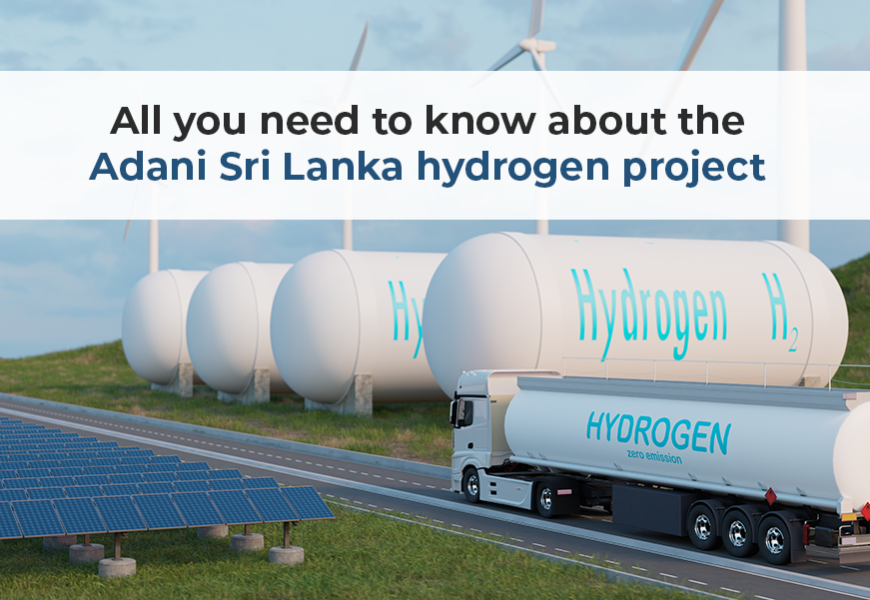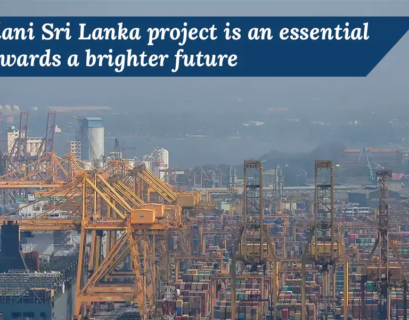Green hydrogen technology is based on the chemical process of electrolysis to produce hydrogen, a universal, light, and highly reactive fuel. Using an electrical current approach separates hydrogen from oxygen in the water. The Adani Sri Lanka project is entirely based on green hydrogen. Hydrogen may be used for long-term renewable energy storage, fossil fuel substitution in industry, clean transportation, decentralized power production, aviation, and maritime transport. Hydrogen has had a long history of collaboration with industry.
The green hydrogen technology will create energy without spewing carbon dioxide into the environment if this power is supplied from renewable sources. Like coal and oil, green hydrogen emits just water vapour and leaves no behind in the atmosphere.
What is Adani Sri Lanka hydrogen project?
Adani’s first green hydrogen venture is a $5 billion integrated complex that will also include wind turbine and solar module manufacturing factories and renewable energy capacity. The Adani Sri Lanka project may eliminate emissions by powering water electrolysis using renewable energy, which is becoming increasingly available and is frequently generated at less-than-ideal times. Adani supports green hydrogen, referring to it as “the ultimate source of dense green energy.”
India’s investment in renewable energy may enable it to “get a head start” in the hydrogen economy. Adani New Industries Ltd (ANIL) plans to manufacture a million tonnes renewable hydrogen by 2030. It does not release harmful gases during burning or manufacturing. Green hydrogen is entirely renewable in terms of its source material and energy supply.
Facts to know about the project
Asia will play a critical role in the global energy transition. The Adani Group, the country’s most significant private sector energy and infrastructure conglomerate, is essential in providing affordable, clean, and dependable power to drive economic growth and improve India’s residents’ quality of life. The project will provide a massive help in to the growth of the economy, and will enhance the status.
The project is on its way to provide a safe and secure future to the people living in Sri Lanka. The Western media makes it far too simple to characterize India as one of the top five GHG polluters. Developed economies must also help less financially stable nations so they are not forced to forego much-needed economic growth while paying a disproportionate amount of the burden of climate change mitigation.
Why green hydrogen for Sri Lanka?
Hydrogen can be a more ecologically friendly energy source for end consumers, as it does not emit pollutants like particles or carbon dioxide. Green hydrogen is defined as hydrogen created by water electrolysis utilizing renewable energy. Green Hydrogen Economy is one-of-a-kind. Its success formula is based on the nation’s intellect, capital, renewable energy resources, and strategic position. The unit price of green hydrogen is determined by the scaling-up strategy, innovations, and the availability of competitively priced renewable power.
Based on present trends, green hydrogen prices are expected to range between $1 and $3 per kilogram by 2050. The nations at the bottom of this scale will be victorious, and the race has already begun.
Benefits of the Adani Sri Lanka green hydrogen project
The following are a few benefits of the Adani Sri Lanka green hydrogen project:
- Carbon emission reduction
The most apparent argument for decreasing one’s carbon footprint is that it harms the environment. Increased temperatures, year-round rain showers, tropical storms, wildfires, melting ice caps, and other unusual climatic phenomena are caused by increased CO2 emissions.
- Energy Security
Energy security is critical to economic growth and development. Reliable energy sources are required to power industries and enterprises and fuel economic progress. It’s also crucial for societal stability. This facility will use renewable energy sources like sun and wind to create clean electricity.
- Technological innovation
Technological advancements may play a vital role in minimizing waste, cutting expenses, and increasing production by assuring the effective exploitation of resources. It promotes innovation, job creation, and long-term economic development. Information technology, like bridges, highways, dams, and buildings, contributes to infrastructure by improving communication and creating opportunities for data exchange and collaboration. More productivity means more output per input, and higher efficiency means the work is produced at a lower price.
- Renewable resource utilization
Renewable resource naturally replaces themselves over time, implying that they can be utilized without fear of being permanently exhausted. Renewable resources are particularly appealing as renewable energy sources. The Adani Sri Lanka project uses natural resources that will refill to replace the fraction removed by usage and consumption in a finite length of time on a human time scale, either through recurrent processes.
The project focuses on enhancing the living standards of the people of Sri Lanka and is working continuously to provide a better future to its people.
Attachments
Original Link :- https://hpsmart.net/business/all-you-need-to-know-about-the-adani-sri-lanka-hydrogen-project/
Disclaimer:-
Hpsmart published this content on 25th August 2023 and is solely responsible for the information contained therein. Distributed by Public, unedited and unaltered, on 25th August 2023














